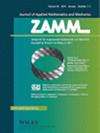Radiative heat transport of cattaneo‐christov double diffusive casson nanofluid flow between two rotating disks with hall current and activation energy
IF 3.2
4区 工程技术
Q1 MATHEMATICS, APPLIED
Zamm-zeitschrift Fur Angewandte Mathematik Und Mechanik
Pub Date : 2023-10-18
DOI:10.1002/zamm.202200419
引用次数: 1
Abstract
Abstract The present research uncovers the mathematical exploration of the magnetohydrodynamic radiative Casson nanofluid flow produced due to stretching and coaxially rotating surfaces of two disks inside a non‐Darcy porous medium under the dominance of the diacritic Hall current and heat generation. The energy field is displayed under the dominance of radiative and dissipative heat transport by involving the consequences of distinctive nonlinear thermal radiation, viscous dissipation, and Joule heating. The present study overcomes the barrier of heat and mass transport by annexing Cattaneo‐Christov double diffusion effects. The current exploration shows the characteristics of the concentration field due to arising chemical reaction incited by activation energy. A substantive mathematical problem is modeled by assigning nonlinear partial differential equations together with convective boundary conditions. A compatible similarity transformation comprised in the current study is exerted to produce a set of nonlinear ordinary differential equations with competent boundary conditions. The resulting mathematical model is numerically solved via dispensing the SLM. The present article deals with an in‐depth exploration of diagnostic flow parameters' attributes against the flow field and efficient physical quantities with the help of distinctive graphs and tables. As per the current investigation, the energy field becomes potent due to enhancing the stretching of each of the disks. Besides, augmenting the thermophoretic diffusion and chemical reaction boosts diluting the concentration of nanoparticles. The flow along the radial direction gets controlled near the upper disk under the increasing influence of the Hall current, intensity of the magnetic field, and stretching rate of the lower disk. On the other hand, the enlarging Casson parameter, rotation parameter, and stretching parameter for the lower disk lead to controlling the flow along the radial direction adjacent to the lower disk. Apart from that, the intense effects of the stretching rate of the upper disk and rotation rein axial flow throughout the flow region.具有霍尔电流和活化能的两个旋转圆盘间cattaneo - christov双扩散卡森纳米流体流动的辐射热传递
摘要本研究对非达西多孔介质中两个圆盘的表面在变分霍尔电流和热量的作用下拉伸和同轴旋转而产生的磁流体动力学辐射卡森纳米流体流动进行了数学探索。能量场在辐射和耗散热输运的主导下显示,涉及独特的非线性热辐射,粘性耗散和焦耳加热的后果。本研究通过附加Cattaneo - Christov双扩散效应克服了热和质量输运的障碍。目前的探索显示了由活化能激发的化学反应引起的浓度场的特征。通过赋值非线性偏微分方程和对流边界条件来模拟一个实质性的数学问题。本文提出了一种相容相似变换,得到了一类具有适态边界条件的非线性常微分方程。通过分配SLM,对所得数学模型进行了数值求解。本文借助独特的图形和表格,对流场和有效物理量的诊断流参数属性进行了深入的探索。根据目前的研究,能量场变得强大是因为增强了每个圆盘的拉伸。此外,热泳扩散和化学反应的增强促进了纳米粒子浓度的稀释。在霍尔电流、磁场强度和下盘拉伸率的影响下,沿径向的流动在上盘附近得到控制。另一方面,增大下盘的Casson参数、旋转参数和拉伸参数控制了下盘附近径向的流动。除此之外,上盘的拉伸率和旋转的强烈影响控制了整个流动区域的轴向流动。
本文章由计算机程序翻译,如有差异,请以英文原文为准。
求助全文
约1分钟内获得全文
求助全文
来源期刊
CiteScore
3.30
自引率
8.70%
发文量
199
审稿时长
3.0 months
期刊介绍:
ZAMM is one of the oldest journals in the field of applied mathematics and mechanics and is read by scientists all over the world. The aim and scope of ZAMM is the publication of new results and review articles and information on applied mathematics (mainly numerical mathematics and various applications of analysis, in particular numerical aspects of differential and integral equations), on the entire field of theoretical and applied mechanics (solid mechanics, fluid mechanics, thermodynamics). ZAMM is also open to essential contributions on mathematics in industrial applications.

 求助内容:
求助内容: 应助结果提醒方式:
应助结果提醒方式:


